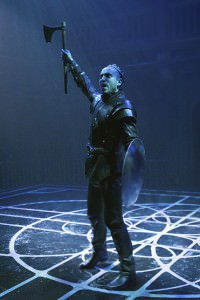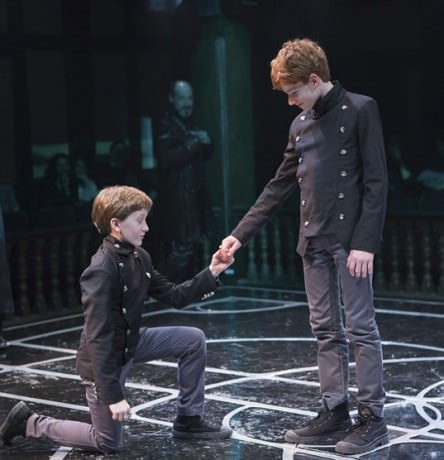Richard III is one of Shakespeare’s most popular plays, and with good reason. In his fascinating interview posted on the National Theatre’s website, Sir Ian McKellan notes the play’s relevance. “Ever want to get inside the mind of a bully?” Certainly on the international scene, he adds, there is no shortage of Richards. As an actor who has successfully played Richard on stage and screen, McKellen’s insight into the character is exceptional; yes, Richard does dreadful things, but he is afflicted with a disability, and although a gifted warrior who virtually set his brother on the throne, he has been pointed at, vilified, and disliked by his mother for his whole life.Yes, Richard is bad, bad, bad; but he is not without charm, and he is, in his own way, viciously entertaining.”

Even George Bernard Shaw, no fan of Shakespeare, has said, “Of all Punch and Judy shows Shakespeare’s Richard III is the best. It has abundant devilry, humor and character presented with luxuriant energy of diction in the simplest form of blank verse.” Samuel Taylor Coleridge refers admiringly to the theme, noting Richard’s intellectual vanity: “Shakespeare here, as in all his great parts, develops in a tone of sublime morality the dreadful consequences of placing the moral, in subordination to the mere intellectual, being.”
The recent discovery of Richard III’s remains under a parking lot in Leicester adds a frisson of extra excitement to Shakespeare’s play. Here in DC, we are especially fortunate to have a ground-breaking production, in which trap-doors become graves, music and shadow play tricks on the imagination, and the whole is permeated with sorcery and magic. It is not difficult to do a good production of Richard, although the play is uneven; but it is rare to see, as here, a version in which every aspect contributes to a vision of the play which is as original as it is terrifying.
Director Robert Richmond has said, “The recent discovery of Richard’s bones makes it time to truly explore the complex psyche of one of England’s most controversial kings whose legacy is written as much in blood as it is in ink”. He has transformed the Folger into a theatre in the round for this production. The innovative staging, Richmond believes, “will surely prove to be an immersive experience which will surround the audience with the chaos of the struggle for a kingdom, and give a look into the corrupt mind that Richard hides beneath his deformed body.”
Many historians have noted that history is written by the winners, and that Shakespeare had every reason to make Richard look as bad as possible. After all, Queen Elizabeth was the descendant of Henry VII, who ultimately defeated Richard and founded the Tudor line.
Shakespeare’s play is largely based on Thomas More’s biography of Richard, which set the tone for later depictions of Richard as a preternaturally clever and vindictive monster.
As King Richard, Drew Cortese, making his Folger Theatre debut, is blithely hypocritical and eerily self-possessed. This Richard can order a murder as easily as an exhausted DC lawyer can order a dinner from seamless web. His shock and hurt when his mother curses him are particularly fine, suggesting the torment which underlies his murderous behavior.
Shakespeare’s Richard is fiendishly self-aware, frighteningly amoral, and, in the beginning at least, amazingly successful. He has been called “[a] great killing machine (Victim or Monster? By Harold Bloom, Newsweek, February 8, 2013); a “mixture of intellectual vigour with moral depravity” (Characters of Shakespeare’s Plays by William Hazlitt, 1817, University of Toronto English Library online); and one who “seduces us into a ‘bond of complicity’ in what becomes a series of ever more repellent acts of betrayal and murder.” (Ron Rosenbaum, The Shakespeare Wars, Random House, 2006.)
Howard W. Overshown as Buckingham stands shoulder to shoulder with his Richard (most of the time, anyway) and the two form a partnership in crime that initially at least proves beneficial to both. Overshown capably conveys each shade of emotion, at times seeming like a Mafia don, at other times like a company man asking for his reward after doing a particularly unpleasant favor for his boss.
As Stanley, Richard Sheridan Willis creates a smoothly manipulative operator, who is just smart enough to survive while others fall prey to greed or naivete.
Michael Sharon (Clarence) is startlingly effective, and his rendition of Clarence’s dream, a much-admired section of the play, is probably one of the best I have seen. He proves equally valuable as Catesby, one of Richard’s enforcers. In another dual role, Michael Gabriel Goodfriend shines equally as Rivers and Richmond, giving individuality and power to both roles.
Paul Morella’s Edward IV has one of the most moving scenes in the play, as he mourns the death of his brother Clarence. His grief is mature and deep, and he lives up in every way to the promise of the scene. As the Mayor and Norfolk he is so convincing that it is hard to imagine he ever played Edward.
Sean Fri has a subtle way with the character of Hastings; his bluff good nature makes him an easy victim for Richard, and he effortlessly conveys his status as Edward IV’s childhood friend. As Tyrell, a monstrous role, he performs beautifully, particularly considering that he has one of the most difficult scenes in the play.
Harold Bloom has referred to the play as “any actress’s nightmare”, and it is easy to see why. (Harold Bloom, Shakespeare: The Invention of the Human, Riverhead Books, 1998.) Lamentations and curses are difficult to play, and the women in Richard’s world have plenty of both. None of them, as written, seem to be in charge of their own destiny; when they are thwarted, they rage; when they are bereaved, they weep; but despite their heavy burdens of loss, they have few choices which can lift them out of it. Desmond Seward notes in his The Wars of the Roses (Viking, 1995) that women’s emotions in many ways were not considered important enough to be recorded at the time. The women’s stories in the play are not particularly historically accurate, but they are certainly full-blooded and dramatic. And the actresses certainly rise to the occasion.
Naomi Jacobson’s Queen Margaret is a revelation. gloriously angry, driven mad by misfortune, she turns each of Margaret’s incantations into a fresh prophecy of doom. She is ageless, almost outside time; driven by an intensity of pain that turns her energy outside to curse at the world which has betrayed her.
Alyssa Wilmoth Keegan (Lady Anne) is quite different, yet also compelling. She seems at first a sensible woman, sensible even in the midst of great pain. When she meets Richard she curses at him (almost everyone does) and her change of heart is rendered as the capitulation of a woman in shock, who is so unhappy she is almost sleepwalking, and her choice of Richard seems understandable because in her unsettled mind she has nowhere else to go.
Julia Motyka’s Queen Elizabeth, wife of King Edward IV is at first appealingly brittle; her stature and manner portray the “painted queen” to perfection. As she grows she becomes not only stronger but fiercer, and more determined. Her final scene with Richard is a highlight of the production.
The lovely Jenna Berk (Princess Elizabeth) does not have much to do; in fact Elizabeth is often not included in the play at all. But she is a very important figure, because it is her union with Richmond which ends the War of the Roses and sets the stage for the new Tudor era. She handles her role with dignity and aplomb, and her interaction with the princes is particularly charming.
Nanna Ingvarsson as the Duchess of York, mother of Richard, Edward IV, and the Duke of Clarence, is central to the play, as Richard’s mother. Clearly their relationship is poor, and she ends the play by cursing him, but her anguished knowledge of what her son is turns her into an almost tragic figure. When she curses Richard he visibly melts; and we see the terrible truth of their relationship, and the impact it has had not just on Richard but on the fate of the realm itself.
Andrew Criss (Ratcliffe/Friar) and Daniel Flint (Lovell/Archbishop of Ely/Friar) find unique characterizations for each role they play. Their work is central to maintaining the overall tone of the play, and when needed they provide the requisite hypocritical saintliness or menace that is required. One is reminded of the ancient rhyme: “The Cat, the Rat, and Lovell our dog, all rule England under the Hog.” According to Holinshed, a poor man named Collingborne who wrote this catchy verse was executed by Richard for his pains.
Holden Brettell (Prince Edward) and Remy Brettell (Duke of York) are simply perfect; Prince Edward has a captivating air of innocence, and the Duke of York’s astute jibes irritate Richard to no end. There is still no definitive solution to the mystery of the murder of the princes in the Tower, Richard’s nephews, who were allegedly killed by Richard in his quest to become king. Members of the Richard III Society argue fiercely fr his innocence. Other candidates for the murderer have been put forward, such as Buckingham and Richmond. As far as the murder of Henry VI, John Ashdown-Hill (The Last Days of Richard III and the fate of his DNA, The History Press, 2013) and Alison Weir (The Wars of the Roses, Ballantine Books, 1995), two historians with very different views of Richard, agree that If Richard was involved the order to kill Henry likely came from Edward IV. This is just one of the many mysteries that surround Richard; very few have been resolved, and some likely never will be. This just adds to the appeal of the story.

The production design is, quite simply, brilliant. Tony Cisek’s set adds a whole new dimension to meaning of the play, as set design does at its best. Mariah Hale’s costumes are evocative and stylish. Lighting Design by Jim Hunter and music by Composer and Sound Designer Eric Shemeolonis are spectacular. Fight scenes choreographed by Casey Kaleba are handled deftly and with panache. The music is hauntingly beautiful, and the use of sound is profoundly affecting.
This production is, as its director promises, essentially immersive; each element works together to create a mysteriously mesmerizing yet explosive whole.
Director Robert Richmond and his creative team have combined their talents beautifully to create a Richard III that is simply unforgettable. We may never know the truth about him. But we will never stop wanting to know.
Running Time: Approximately three hours, with one 15-minute intermission.
Richard III plays through March 9, 2014 at Folger Theatre at the Folger Shakespeare Library—201 East Capitol Street, SE, in Washington, DC. For tickets, call the box office at (202) 544-7077, or purchase them online.





